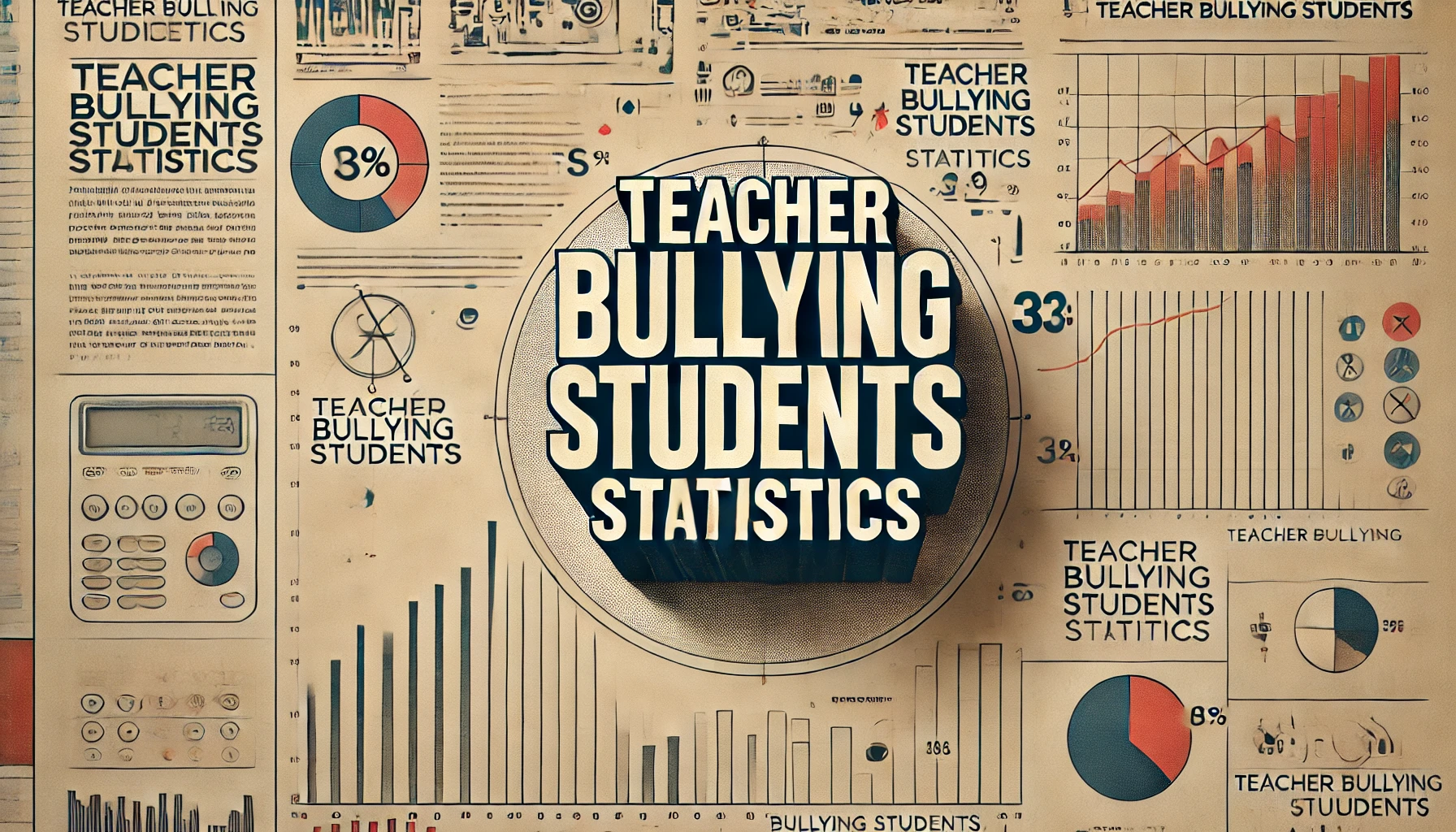Teacher Bullying Students’ Statistics ad Facts
Updated · Jul 15, 2024

WHAT WE HAVE ON THIS PAGE
Introduction
Teacher Bullying Students’ Statistics: Bullying amongst peers and co-workers is a very commonly known fact. However, the topic that has the least attention is the bullying of students by teachers. The article further focuses on reviewing the statistics behind teachers bullying students. Teachers bullying students occur in school-related contexts globally in many different ways and to different extents. Even though the rate of teachers bullying students is almost 0.6%, it is necessary to shed more light on this challenge.
Many surveys have found that being exposed to teachers’ bullying can negatively affect a child’s psychological and physical health. Teacher bullying is an essential topic for future research.
Editor’s Choice
- Nearly 49% of the kids between 4th and 12th grade announced that they were being bullied by other kids in school at least once time in a month.
- Almost 2% of the students in the middle school stated being bullied by their teachers in the classroom.
- According to 23% of the youth stated that they were being bullied 2 to 3 times in previous months.
- Nearly 30% of the students from secondary school have reported being bullied by their teachers.
- Female children in school from families having high socioeconomic status were shown to be sufferers of oral abuse from their teachers less likely than other students.
- Almost 20% of the children from 9th to 12th grade reported that they were bullied in the United States.
- Virtually 64% of the youths stated that they were bullied by their teachers once throughout their lifetime.
- Around 71% of the teenagers said that they experienced bullying in their school days.
- 70% of the staff in school have seen students getting bullied.
- Almost 93% of high school and college students recognized at least one teacher as a bully in school.
- Roughly 30% of the youths agree to bully others once during their school times.
- Male children in school are likely to discern themselves as being a sufferers of teacher’s mistreatment.
- The school-based bullying avoidance programs lowered bullying by almost 25%.
- 43% of the children who are bullied state they have notified a school staff member.
- Nearly 57% of the bullying stops when a peer interferes on behalf of the students being bullied.
Teachers’ Bullying of Students
- The school children are bullied at school almost thrice, likely to participate in misconduct and become violent.
- Students who are bullied are 1.7 times more prone to attempt suicide, which can also result in depression, lower self-respect, anxiety, low academic performance, school violence, and also facing family issues.
- Nearly 17% of Hispanics, 22% of Caucasians, 25% of African Americans, and 9% of Asian students have been bullied by teachers or their classmates.
- The females are more prone to be bullied than the males.
- Almost 24% of females are bullied, compared to 17% of males.
- Practically half of the students feel social persecution, and 29% of the students feel physical bullying.
- A bully can be done for any reason, like body shaming, color, or cast.
- Around 79% of the children in school are orally abused, with almost 29% of that abuse coming from the teachers in the classroom.
- Nearly 70.1% of LGBTQ children in school witness bullying for their inclination from both the teachers and their classmates, with almost 59.5% of them feeling secure and 34.8% skipping classes.
- The students from 6th, 7th, and 8th grade are bullied by the teachers for low marks at a high rate.
- Nearly 2% to 30% of secondary and middle school students witness bullying by their teachers, and 64% to 93% of teenagers and college students can guess at least one teacher who always bullies them.
- Almost 15% of the children face bullying from teachers, even though they get good grades.
- Almost 160,00 students have a fear of attending school every day due to cyber, physical, and moral bullying.
- Almost 28% to 30% of the kids in school in 6th to 12th grade have either been the sufferer of bullying or have been bullied by other students, and almost 10% to 14% of the sufferers have been bullied for almost six months continuously.
- Roughly 30% of the students between 12 years and 18 years age group have faced bullying based on gender, disability, color, religion, sexual orientation, and also physical appearance.
- Almost 20% of the kids executed violence against the teacher, 41.7% of the teachers stated being bullied, and 4.9% of teachers witnessed bullying in the form of disrespect.
- Nearly 20% of the kids in the school between 12 years to 18 years have witnessed bullying, and 46% of the children have observed an adult at the school premises about it.
- Roughly 15% of the children have reported being the subject of rumors that are spread, and 14% stated being made fun of, called unusual names, insulted, and excluded from team activities.
- Almost 87% of the people who were involved in the survey think that shootings are motivated by a wish to respond against those who have insulted them.
- 54% of the people think that experiencing physical abuse at home can result in violence at school.
- 61% of people witness that school students shoot others because they already have been the sufferers of physical abuse at home.
- Bullying is a planned problem in almost 14% of the public, with an almost high rate of occurring in middle schools.
- Almost 64% of young teenagers state that being bullied by the teachers at least one time in their life.
- Bullying happens on school premises, with almost 43% happening in the hallways.
- Almost 15% of students get bullied by teachers at some point in their lives.
- Nearly 64% of the young teenagers stated being bullied by a teacher once in life.
Countries with the Most Cyberbullying in the World
We’ve gathered data on cyberbullying from various countries to understand its impact on children and adolescents around the world. Here’s what we found:
- France: About 9% of children in France have experienced cyberbullying. In 2019, over 40% of people under 50 faced online attacks.
- Spain: Cyberbullying affects 9% of Spanish children. A survey in 2018 showed that nearly 7% of young people experienced cyberbullying, often related to factors like sexual orientation or skin color.
- Hungary: Around 10% of Hungarian children are affected by cyberbullying. The lack of specific anti-bullying laws and nationwide programs is a concern.
- Romania: About 11% of Romanian children experience cyberbullying, with 17% admitting to sending offensive messages.
- Poland: Cyberbullying impacts 12% of Polish children, with name-calling being the most common form.
- Italy: Approximately 12% of Italian children are cyberbullied. Italy has laws defining cyberbullying as a crime and mandating internet education in schools.
- South Korea: Cyberbullying affects 13% of South Korean children. Stricter measures are being implemented following tragic incidents.
- Peru: Around 14% of Peruvian children experience cyberbullying, especially in economically disadvantaged areas.
- Argentina: Cyberbullying affects 14% of Argentinian children, with the country ranking fourth globally for online bullying.
- Germany: About 14% of German children experience cyberbullying, with boys being more involved than girls.
- Serbia: Cyberbullying impacts 16% of Serbian children, with UNICEF emphasizing mental health risks.
- China: Around 17% of Chinese children are affected by cyberbullying, prompting authorities to draft guidelines.
- Great Britain: Cyberbullying affects 18% of British children, with Instagram being a primary platform for bullying.
- Mexico: Approximately 18% of Mexican children experience cyberbullying, with various types of harassment reported.
- Australia: Cyberbullying impacts 19% of Australian children, with lasting effects on mental health.
- Saudi Arabia: About 19% of Saudi Arabian children experience cyberbullying, with internet use being a contributing factor.
- Turkey: Cyberbullying affects 20% of Turkish children, with offensive messages being common.
- Canada: Approximately 20% of Canadian children are cyberbullied, with specific laws in place to address bullying.
- Sweden: Around 23% of Swedish children experience cyberbullying, with victimhood correlating with psychosomatic problems.
- Malaysia: Cyberbullying affects 23% of Malaysian children, prompting calls for dedicated legal frameworks.
- Belgium: Approximately 25% of Belgian children experience cyberbullying, with significant overlap with school bullying.
- South Africa: About 26% of South African children experience cyberbullying, leading to various negative consequences.
These findings highlight the widespread nature of cyberbullying and the urgent need for effective measures to address it globally.
Teenage Suicide statistics
- Latino girls notably show a high rate of suicide attempts as compared to white or black teen girls.
- Almost 50% of the students in high school have a history of depression and anxiety.
- Around 18.8 % of teenagers have considered suicide in their lives.
- Suicide thoughts were notably high in the students identifying as 12.7% gay or lesbian, 16.0% questioning, and 18.8% bisexual.
- Nearly 88.6% of the teenagers who have died by committing suicide had contact with doctors within the year before their death.
- From the high school students, almost 19% of females and 16% of males reported being bullied within the school premises in the United Nations.
- At least 14% of the teens have reported self-harming in their school days because of bullying.
- Almost 2 million American high school attempted suicide in the year 2019.
- Male teenagers are more prone to attempt suicide due to depression than females.
- Suicide rates have gradually increased because of the time teenagers spend on social media.
- In past years, the suicide rate for girls was 15% to 19%.
- 20% of each six high school students have attempted suicide plan in the past 12 months.
- Almost 7% of secondary school students attempt suicide.
- Nearly 17% of teenagers consider depression as a disease, and, to end it, attempt suicide.
- Nearly 60% of the suicide cases in people are not pre-recognised.
Bullying Statistics 2024
- Males (26%) are more likely to get bullied than females (21%) in Canada.
- Generally, 1 out of 3 students are bullied in school years in New Zealand.
- Almost 1 out of 4 kids, that is 25%, has stated being bullied regularly in the last seven months in Australia.
- Almost 70.6% of the teenagers say that they have seen bullying once in their school life.
- Normally, 30% of teenagers have been intentionally targeted, humiliated, and intimidated by an individual or a group through using smartphones or the internet in England.
- Students who are overweight are mostly 63% more prone to be sufferers of bullies.
- Almost 36.5% of the United States students stated that they have witnessed bullying in their school.
- In the past years, 43% of teenagers were sufferers of cybercrimes and cyberbullying.
- Nearly 30% of teenagers witness bullying others in surveys.
- In the United States, almost 55.2% of LGBTQ students have felt unsafe at school because of their sexual orientation.
- More than 1 out of 6 students stated that they were being bullied in their school years in the United States.
- Mostly, 20% of the students in the United States between 12 years and 18 years think that bullying worldwide.
Facts of bullying
- Almost 50% of the students between 12 years and 18 years old reported experiencing bullying and thought their bullies could impact what other students thought of them.
- Nearly 42% of the students have daily reported being bullied in school, which indicates that the bullying was related to at least one of the characteristics.
- The students are less prone to get bullied as they get older. Just 39% of the high secondary school students report being bullied.
- Mostly, 70% of the school staff have regularly seen bullying. Almost 62% experience bullying two or more times in each month, and 41% experience bullying one time in a week.
- Almost 31% of the students in the 6th standard witness maximum bullying.
- 57% of bullying situations are avoided when a senior gets involved on behalf of the students.
- The students who report being generally bullied score less in mathematics, science, and reading than their peers who report not being bullied.
- According to Petrosian, 64% of the children who are bullied don’t report it.
- Almost 87% of the students said that bullying Is the main influencer of school shootings.
- Other kids making fun of certain students gives extra motivation to other kids to bully other kids.
- Teacher Bullying students statistics state that revenge is the main reason for the school shooting in the United States.
- Every month, 282,000 school students are insulted physically in some or the other way in secondary schools throughout the United States.
- Almost 10% of the school students who drop out of school do this because of being bullied all the time.
- Nearly 70.6% of the students think that having experienced bullying in their school days.
- As per stopbullying.gov, 20% of the students from 9th and 12th standard witness bullying.
- Almost 28% of the kids from 6th and 12th standard feel bullied.
Bullying in Australia
- Almost 6.5% of the students in Australia reported suffering from social exclusion because of bullying.
- In 2020, 9.3% of the students in Australia generally witnessed symptoms of concern because of bullying.
- 50% of teenagers in Australia think that homophobic language and behavior are mostly common in school.
- Almost 81% of the Torres Strait Islander and Aboriginal students stated that they witnessed bullying in school in Australia.
- Almost 20.8% of the students in Australia state that they have been physically bullied.
- Generally, 561 schools in Australia take part in the National Day of Action against violence and bullying.
- In 2021, 80% of the students who faced cyberbullying also faced face-to-face bullying in Australia.
- In 2020, 10.9% of Australian students witnessed cyberbullying.
- Almost 36% of the students in secondary schools in Australia principals find bullying as a main issue in the school.
- Nearly 37.3% of the students in Australian schools state that they are being bullied every few weeks or more often.
- Nearly 1 in 5 students in Australia between 8- and 14 years old witness bullying.
Conclusion
Teacher bullying of students is a very crucial issue that can have a long-term bad effect on the student’s school performance, personality, and mental well-being. The teachers and other staff in school must be alert and speak up against teachers bullying students. It has to be a combined work to create a sound, safe, and supportive learning environment for the students. The statistics introduced in this blog demonstrate teacher bullying and the need to grow awareness and prevention efforts.
It is the responsibility of the teachers to provide a safe and healthy environment to the school students, as they spend maximum time in school itself.
Sources

Joseph D'Souza started Techno Trenz as a personal project to share statistics, expert analysis, product reviews, and tech gadget experiences. It grew into a full-scale tech blog focused on Technology and it's trends. Since its founding in 2020, Techno Trenz has become a top source for tech news. The blog provides detailed, well-researched statistics, facts, charts, and graphs, all verified by experts. The goal is to explain technological innovations and scientific discoveries in a clear and understandable way.



